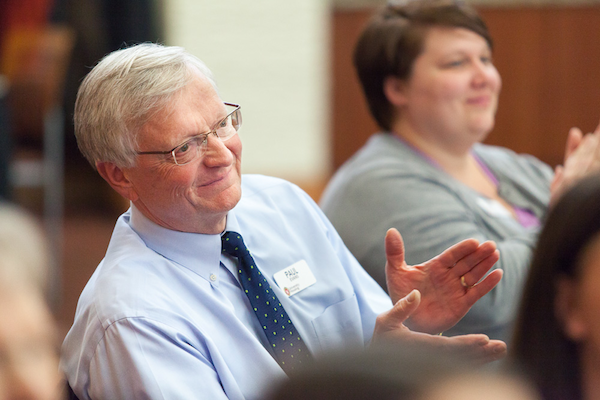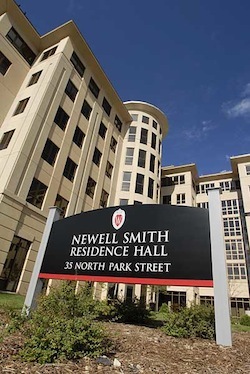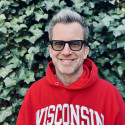Paul Evans led University Housing through renewal and growth

University Housing Director Paul Evans led on-campus housing through an era of growth and revitalization. He retires next month after a 36-year career, the last 16 years as director.
Photo: Joel Ninmann
Sometimes we choose our career, and sometimes a career chooses us.
That may be the case with UW–Madison Housing Director Paul Evans, who first went to college with the idea of becoming a dentist, but next month leaves the university after 36 years, his entire career spent in housing.
As Evans likes to point out that when young people think about their future career path, his is not a profession that immediately comes to mind.
“My kids used to always joke with me about that. ‘Hey dad, did you ever want to grow up to be a housing director,’” says Evans.
For the last 16 years, he has led UW–Madison’s housing division as housing director. Evans is credited with helping guide it through an era of renewal and growth with the revitalization of older residence halls and the development of new ones.

An exterior view of Newell J. Smith Residence Hall, a 425-bed residence hall that opened in 2006, and was the the first major residence hall to open on campus since the old Ogg Hall in 1965. It was one of many changes that took place under Paul Evans’ leadership.
“Paul has been a strong leader in making on-campus housing options more accessible to students,” Vice Chancellor for Finance and Administration Darrell Bazzell says. “He also has provided important leadership in creating a residential experience with enhanced opportunities for academic success.”
Evans had gone to college with the intention of becoming a dentist, even going so far as to take the entrance exam for the dental school at Marquette University. But in his sophomore year at UW–Eau Claire, he took a job as a resident assistant, also known as an RA or housefellow.
Evans kept the job in his junior year, and also began working in the campus counseling center. He started to question his original plan, and switched his major to psychology with the intention of working at a campus counseling center.
“I had discovered that I really enjoyed working with students and loved the atmosphere and energy of a campus,” Evans says.
After getting his undergraduate degree, Evans headed to the University of Missouri to get his master’s degree. Again, housing came calling when a job as a hall director opened up. He liked the gig so much that he decided to apply for housing jobs once his degree was completed.
At a conference in Detroit, Evans ran into Marian Laines for UW–Madison’s Residence Life staff.
“For reasons still not known to anyone, she liked me enough to invite me to campus for an interview,” Evans says. “So in July 1978, I began what quickly became and has remained a love affair with University Housing and UW–Madison.”
Evans says there have been a number of watershed moments throughout his career that have shaped the direction of UW’s housing program. The first was when the drinking age was raised from 18 years old to 19, and then from 19 to 21.
“There had been a considerable amount of resources devoted to events that alcohol was a part of. In fact very few events did not involve alcohol,” Evans says. “When the age went up, it significantly changed the programming we could do at residence halls.”
Paul Williams (left), professor in the Department of Plant Pathology, talks about creating a recycled plastic bottle growing system to students in the UW GreenHouse Learning Community in the rooftop greenhouse of Leopold Hall.
The drinking age change was one of the factors that allowed Housing to infuse more academically focused programming, which has led to the establishment of nine residential learning communities on campus.
In addition to the learning communities, there are now academic advisors in a score of University Housing buildings, and classrooms embedded in some residence halls.
“There has been a huge shift in how we’ve connected academics to housing, and it has had a positive impact on student performance and retention,” Evans says.
The first two residential learning communities opened in 1995. The residential learning communities have been expanded to include international learning communities, a community based on sustainability, an entrepreneurial-based community, and a multicultural learning community.
Dean of Students Lori Berquam says Evans’ decision to combine residential living with learning transformed University Housing, helping to connect living and learning through social, cultural and educational activities and opportunities.
“Paul has developed new residence halls that offer students the opportunity to connect their education in the classroom with their lives outside the classroom,” Berquam says. “He loves what he does. He has created a stellar operation that other campuses want to emulate.”
A second change that considerably altered student housing was the change from single-sex residence halls to co-ed.
“It was really a market-driven decision, what the students were requesting,” Evans says.
Evans says the change has been positive for students.
“It’s more a real-world situation. Our world is not segregated by gender,” he says.
The third watershed moment for Evans was the development and implementation of the Housing Master Plan, a process that began in the late 1980s and will continue through 2020, with large renovation projects planned beginning in 2016 including major renovations to Sellery and Witte Halls. In all, the master plan resulted in $300 million invested in University Housing, all paid for by program fees.
Among the projects included in the plan: the construction of the Newell J. Smith, DeJope and Leopold residence halls and the reconstruction of Ogg Residence Hall and the Gordon Dining and Event Center, and the renovation of the Carson Gulley Center.
“There’s been a lot of changes over the years, we’ve got five new buildings, we tore down Ogg Hall, we tore down Gordon Commons,” Evans says. “When I came in ’78, Gordon was only 14 years old. Ogg was only 15 years old. They weren’t very old. So it’s not like the facilities were bad, but if you’re at a place for 36 years, you could live the life of a building.
“The investment that UW–Madison is an acknowledgment of the importance of housing for attracting the best graduate and undergraduate students,” Evans says.
Alan Fish, former associate vice chancellor for facilities at the UW–Madison, worked with Evans on many of the projects. He said Evans brought “a great amount of positive energy” to his work.
Students select from a number of food options at the new Gordon Dining and Event Center, which opened in 2012. The center features a broad range of eating choices with three main dining areas that can accommodate 600 patrons.
Evans focused on the need to have great housing to bring students to the UW campus, Fish said, and recognized that much of the older housing stock needed to be updated.
“If I had a freshman going to UW, I’d want them to stay in a residence hall. Paul is a big reason for that,” says Fish, who is now vice president of real estate and campus services at Johns Hopkins University.
Evans says any success attributed to him should be shared with all those who’ve worked alongside him.
“Nothing I’ve accomplished would have been possible without this great staff we’ve had at Housing. Their contributions have made this a great place to live and to learn and they’re the people who have made this work,” he says.
Evans, who counts golf and fishing among his chief post-retirement pursuits, says he will stay in Madison. His wife Nancy, an educator in the Monona Grove School District, is also retiring. He says they’ve made no immediate plans, but Evans has no doubt he will keep busy.
“Now what I’ve tried to squeeze into a Saturday and Sunday, I can make it spread over seven days, and I don’t have to worry as much about the weather on the weekends because I can always do it on Monday,” he says.
Tags: student life, University Housing



